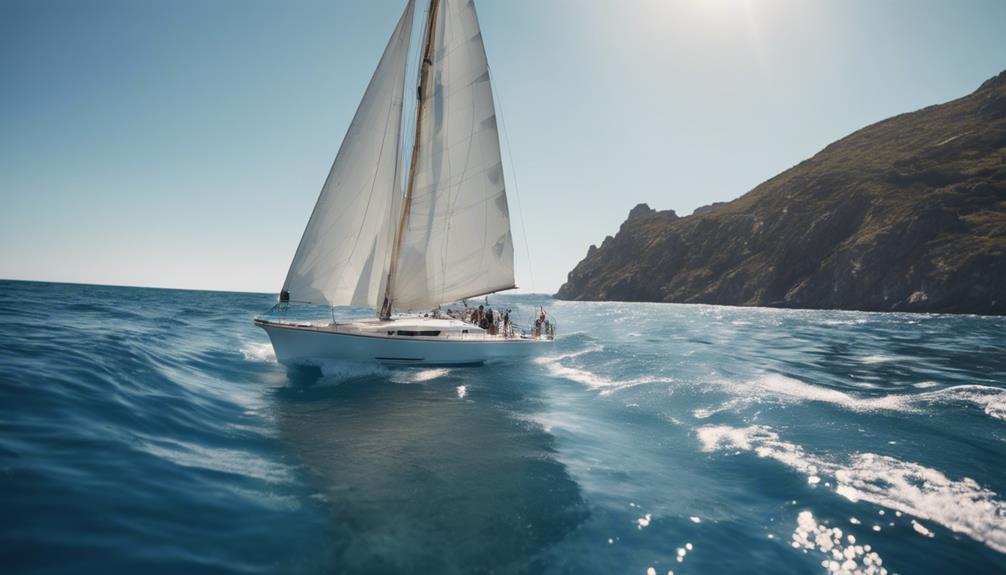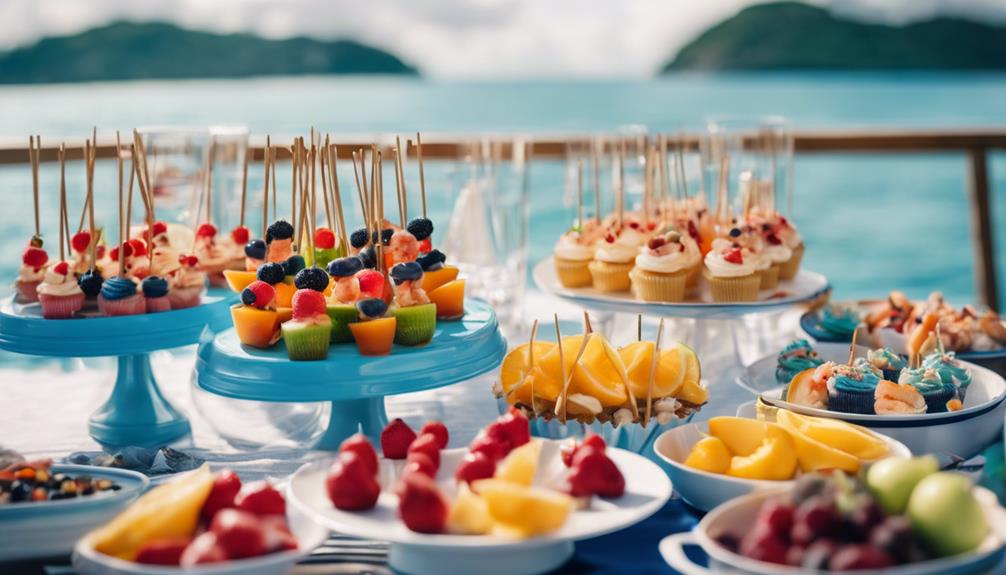The largest sailboat you can comfortably single-hand usually falls between 30 and 40 feet. This size strikes a good balance between manageability and stability, making it ideal for solo sailing. You'll find features like furling mainsails and electric winches help reduce physical strain. Look for boats with self-tacking jibs and organized deck layouts to enhance safety and mobility. While larger vessels offer more comfort, they require greater skill. Proper training and practice will boost your confidence on the water. If you want to discover more about optimizing your solo sailing experience, there's plenty left to explore.
Key Takeaways
- The ideal size for solo sailing is between 30 to 40 feet, balancing manageability and comfort.
- Boats over 40 feet require advanced skills and experience for effective solo sailing.
- Design features like furling mainsails and electric winches significantly enhance solo sailing efficiency.
- Stability is crucial; vessels between 32 and 34 feet provide excellent performance for offshore trips.
Ideal Sailboat Size
When choosing a sailboat for solo sailing, aim for a size between 30 and 40 feet, as this range strikes a balance between manageability and comfort. Boats in the 30 to 33-foot category are often seen as the ideal sailboat size for those venturing out alone. They provide enough space for living and storing gear while remaining easy to handle.
If you consider a boat larger than 40 feet, be prepared for increased complexity. These vessels typically require more experience and skill to sail solo, and handling can become challenging. Boats over 36 feet can be tough for even two people to manage, making them less suitable for solo sailing.
For offshore trips, you'll find that boats between 32 and 34 feet hit the sweet spot, offering good stability and ease of operation.
While smaller boats around 27-28 feet can work, they often demand creative stowage solutions due to limited space. Ultimately, when selecting your ideal sailboat size, keep in mind your comfort and ability to operate the vessel effectively on your own.
Key Equipment for Solo Sailing
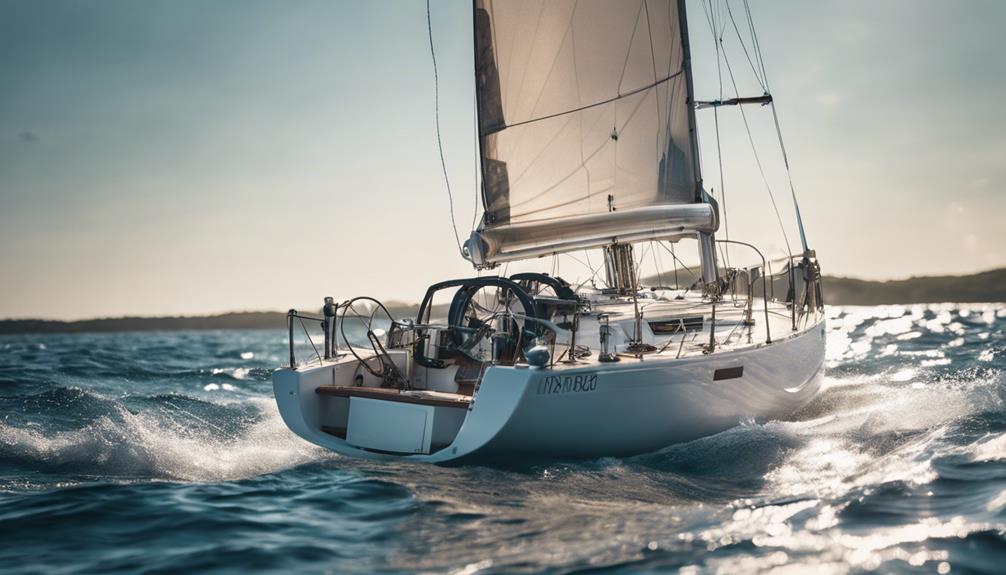
Choosing the right equipment can make all the difference in managing a larger sailboat solo, ensuring you have the tools to sail efficiently and safely.
First, consider investing in electric winches and furlers. These can greatly reduce physical strain and enhance your sailing efficiency. However, always have backup systems ready for critical moments.
Implementing lazy jacks or Stack Pak systems will simplify mainsail handling, allowing you to manage your sails more easily without assistance. A reliable reefing system is essential for adjusting your sail area quickly when wind conditions change unexpectedly.
Autopilots are invaluable; they enable you to maintain your course while freeing up your hands for other important tasks, like adjusting sails or steering.
Finally, route halyards and downhauls to the cockpit. This enhances safety and convenience, letting you operate essential equipment without leaving the cockpit.
All of these pieces of equipment are key to solo sailing on a larger boat, helping you stay safe and make the most of your sailing experience.
Sailboat Design Features

Modern sailboat designs prioritize features that enhance usability and safety for solo sailors, making sailing more accessible and enjoyable.
One of the key sailboat design features you'll appreciate is the incorporation of furling mainsails and smaller headsails. These sails simplify sail management, reducing the physical demands on you while handling the boat.
The deck layout is also vital; a well-organized space minimizes obstacles, enhancing your safety and mobility when maneuvering. You'll find that self-tacking jibs and gennakers offer practical solutions for light air sailing, allowing you to maintain speed without the complexity of spinnaker poles.
Additionally, opting for composite sails can greatly improve performance, as they're lighter and less stretchy than traditional Dacron sails, reducing strain during your solo outings.
Easy access to systems and equipment onboard is essential for effective maintenance and operation, ensuring you can handle any situation that arises smoothly.
Finally, efficient weight distribution contributes to overall boat stability, giving you confidence as you navigate various sailing conditions.
With these thoughtful sailboat design features, you'll be well-equipped to enjoy your solo sailing adventures to the fullest.
Comfort and Stability at Sea
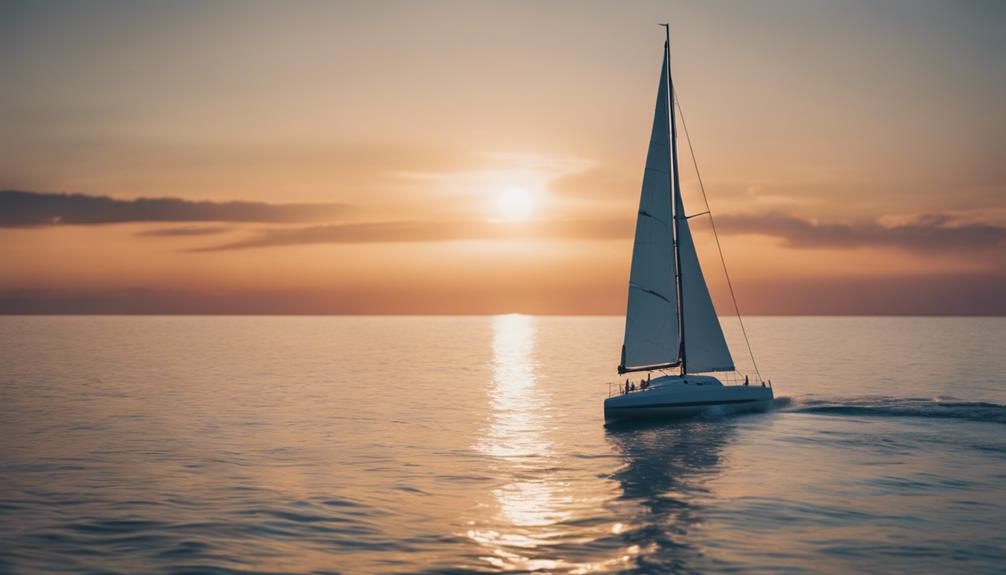
When you choose a sailboat over 40 feet, you'll notice the significant boost in comfort and stability at sea.
Larger vessels offer smoother motion, making your sailing experience far more enjoyable.
With thoughtful design features, these boats guarantee you have easy access to essentials while keeping you safe and secure on your journey.
Boat Size Impact
The size of your sailboat greatly impacts comfort and stability at sea, with vessels ranging from 30 to 40 feet often striking the ideal balance for solo sailors. This range allows you to enjoy manageable handling while still offering enough space for comfort during your journeys. When you sail alone, boat size plays an essential role in your experience.
Consider these factors regarding boat size:
- Manageability: Boats under 30 feet are simpler to handle but may lack comfort for extended trips.
- Stability: While boats over 40 feet provide increased stability, they typically require more skill to manage as one person.
Ultimately, the 30 to 40-foot range is often seen as the sweet spot for solo sailing. It allows you to maintain a comfortable living space while ensuring that the boat remains easy enough to control single-handedly.
Stability in Motion
Stability in motion is vital for solo sailors, as larger sailboats over 40 feet offer a smoother ride and greater comfort during extended journeys at sea. The design of these larger boats inherently promotes better stability, allowing you to handle rough conditions without excessive physical strain. This is important when you're sailing alone, as it enables you to focus on navigation and management rather than battling the elements.
Moreover, larger boats provide better weight distribution and ample space for fuel and water tankage, enhancing your self-sufficiency while out on the water. This stability in motion not only makes your sailing experience more enjoyable but also guarantees that your vessel remains manageable, even in challenging weather.
With increased interior space, you'll find room for better amenities, which can greatly improve your overall comfort. Properly maintained rigging and sail systems on these larger boats further contribute to their stability and control, making them ideal for solo sailing.
Ultimately, the combination of these factors makes larger sailboats a smart choice for those looking to enjoy the freedom of solo adventures at sea.
Comfort Features Design
Comfort features in larger sailboats enhance your experience at sea, making long solo journeys feel more like a home away from home. When you're out there alone, having the right amenities can make all the difference. Larger boats, especially those over 40 feet, not only provide stability but also guarantee that your living space is comfortable and functional.
Consider these comfort features:
- Spacious interiors: Enjoy more room to move around and relax during your time at sea.
- Separate showers: Having a designated space for hygiene keeps you feeling fresh and clean.
With better weight distribution, larger boats reduce the motion you feel, providing a more stable ride. Additionally, enhanced storage solutions keep your living space organized, allowing you to focus on sailing rather than clutter.
Improved tankage for fuel and water also supports self-sufficiency, enabling you to set out on longer journeys without frequent stops. Altogether, these comfort features make your solo sailing experience much more enjoyable.
Essential Sailing Skills

Mastering essential sailing skills is fundamental for solo sailors to navigate safely and efficiently on the water.
You'll need to develop proficiency in mooring techniques, which allows you to dock and undock your vessel without assistance, especially important for boats over 30 feet.
Understanding weather patterns is equally significant; it helps you make informed decisions and manage unexpected changes effectively.
Practice reefing techniques and sail changes in various wind conditions to maintain control while reducing physical strain. This knowledge will prove indispensable in challenging situations.
Anchoring techniques are another key area; getting comfortable with chain stoppers and cleats guarantees your vessel stays secure when you're at anchor.
Familiarity with emergency procedures, like using a harness and jacklines, can't be overlooked. These practices are essential for your personal safety, particularly when you're out at sea on your own.
By honing these sailing skills, you'll build confidence in your solo sailing abilities and enhance your overall experience on the water.
Navigating Adverse Conditions
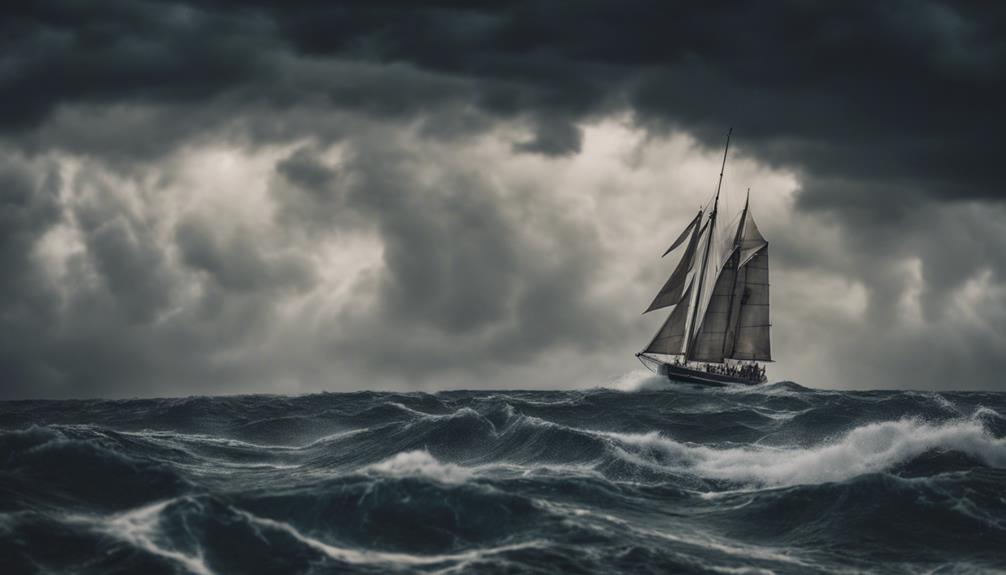
Maneuvering adverse conditions demands a keen awareness of changing weather patterns and the ability to adapt your sailing techniques accordingly. As a solo sailor, you must be prepared to face unexpected challenges. Regularly checking weather forecasts and understanding storm strategies are essential for maneuvering adverse conditions safely.
Here are some key strategies to enhance your safety and control:
- Practice reefing techniques and sail changes in various wind conditions.
- Use harnesses and jacklines to stay attached to the boat, minimizing the risk of going overboard.
Community and Support Resources
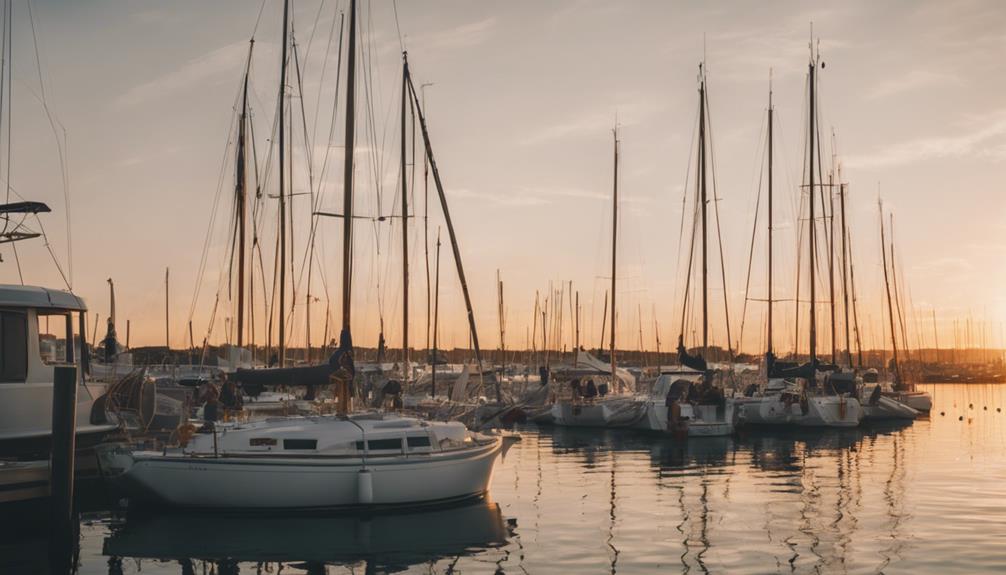
Building a strong network of community and support resources can greatly enhance your experience as a solo sailor, providing both practical advice and emotional backing during your journeys at sea. Engaging with sailing forums and online communities gives you access to valuable insights and shared experiences from other solo sailors. These platforms can boost your confidence and expand your knowledge, especially when you're considering smaller boats.
Local sailing clubs are another fantastic resource, offering camaraderie and mentorship opportunities. Here, you can learn from experienced sailors who can guide you through the challenges of solo sailing. Many solo sailors emphasize the importance of community support, which can be vital during those long stretches at sea when loneliness creeps in.
Participating in workshops and meetups is an effective way to improve your sailing skills and navigate obstacles you may encounter. Additionally, community forums often discuss practical advice on maintenance and repairs, which is essential for staying prepared.
Financial Considerations for Sailors

Financial planning is essential for solo sailors, as the costs associated with owning and maintaining a sailboat can quickly add up. When you begin this journey, you'll need to assess the total cost of ownership, which encompasses more than just the purchase price. Ongoing expenses can greatly impact your budget, so it's vital to plan accordingly.
Here are some key financial considerations:
- Insurance Costs: Costs can vary based on your boat's type, size, and your sailing experience. Always compare options to find the best coverage.
- Docking and Maintenance Fees: These can accumulate, often running into thousands of dollars annually, so factor them into your budget.
Engaging with sailing forums and local clubs can provide insights that help you refine your financial planning. By tapping into shared experiences, you can make informed decisions on budgeting and resource allocation, ensuring you're fully prepared for the financial aspects of your solo sailing adventure.
Solo Sailing Techniques
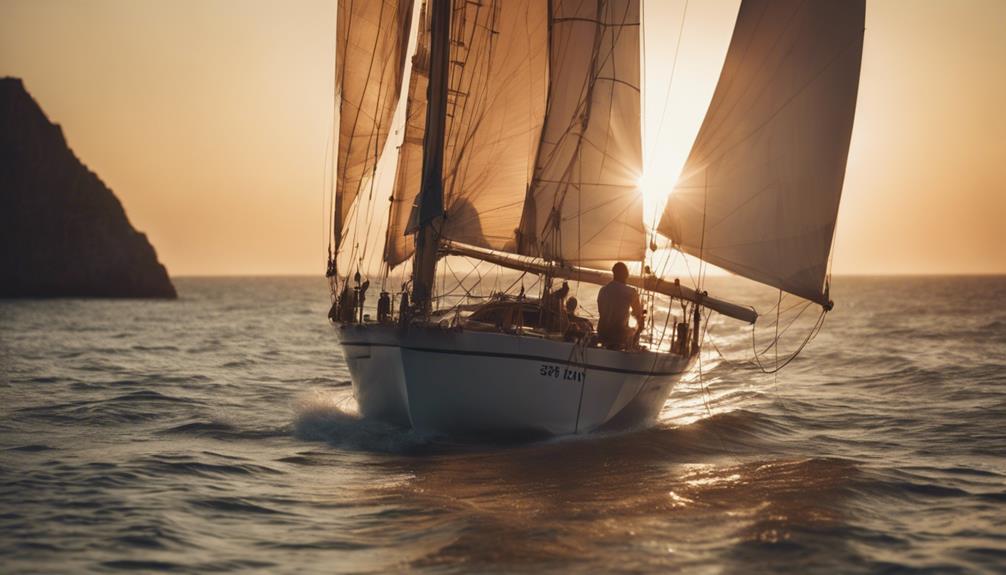
When you're sailing solo, efficient sail management is key to keeping things manageable and safe.
You'll want to focus on safety protocols onboard to protect yourself while handling the boat.
Efficient Sail Management
Efficient sail management is essential for solo sailors, as it allows you to make quick adjustments and maintain control without unnecessary effort. By employing the right techniques and tools, you can streamline your sailing experience, making it safer and more enjoyable.
- Use roller furling headsails: These simplify sail management, enabling you to make adjustments from the cockpit without leaving your post.
- Incorporate lazy jacks or Stack Pak systems: They ease mainsail handling, allowing you to control the sail with less physical strain.
Additionally, a reliable reefing system is vital for managing sails in changing conditions, helping you maintain control during inclement weather.
An autopilot system can also be a game-changer, reducing the physical demands on you during long passages.
With these strategies, you'll find that efficient sail management not only boosts your confidence but also enhances your overall solo sailing experience.
Safety Protocols Onboard
Safety on board is your top priority while solo sailing, and implementing effective protocols can make all the difference in guaranteeing a secure and enjoyable experience. To enhance your safety while living aboard, consider these essential protocols:
| Protocol | Description | Benefits |
|---|---|---|
| Jacklines | Use strong, non-stretch webbing jacklines to stay attached. | Reduces the risk of going overboard. |
| Harnesses | Wear a harness for hands-free movement. | Enhances safety while managing sails. |
| Anchoring Techniques | Master chain stoppers and cleats. | Guarantees stability during solo voyages. |
| Reefing Practice | Regularly practice reefing techniques. | Prepares you for unexpected weather. |
| Docking Procedures | Familiarize yourself with docking and communications. | Crucial for safe maneuvering in ports. |
Preparing for Your Journey
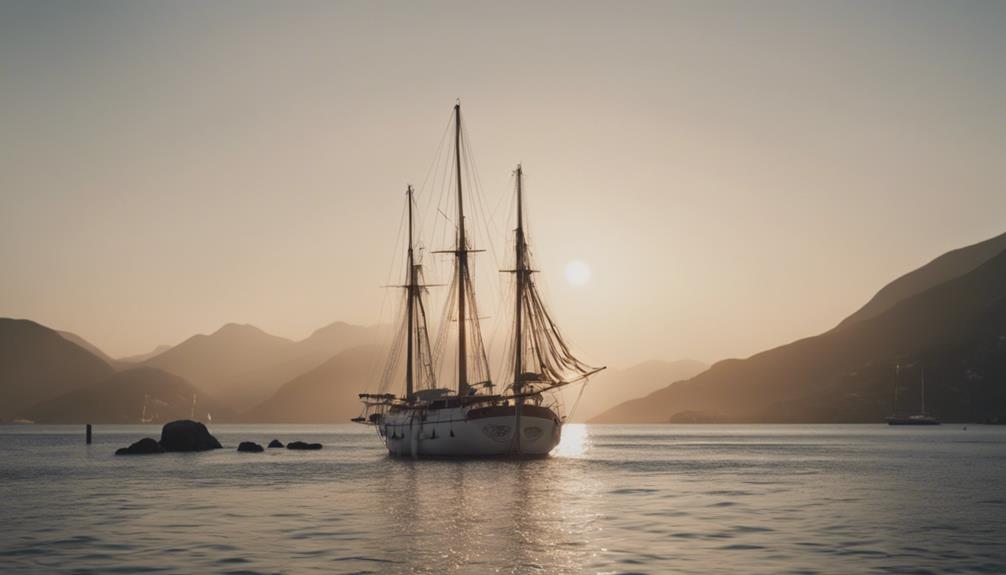
Preparing for a solo sailing journey involves selecting the right sailboat, ideally between 30 to 40 feet, to guarantee manageable handling on your own. A boat in this size range allows you to operate effectively as a single person, giving you the confidence to navigate various conditions without feeling overwhelmed.
To enhance your preparation, consider the following essential items:
- Electric winches: These ease the physical demands of sailing solo, allowing you to manage lines with minimal effort.
- Roller furling headsails: They simplify sail handling, making it easier to adjust sails as conditions change.
Familiarize yourself with your boat's systems and conduct regular maintenance on critical components like winches and autopilots. Practicing maneuvers such as reefing and anchoring in various conditions will greatly boost your confidence.
Frequently Asked Questions
What Is the Largest Boat You Can Operate by Yourself?
You can typically operate a boat up to 40 feet by yourself, but experienced sailors often find around 36 feet to be the most manageable maximum. Your skills and comfort level are key factors.
What Is the Largest Single Mast Sailing Yachts?
When considering the largest single-mast sailing yachts, you'll find impressive options like the Sailing Yacht A at 468 feet. However, for solo sailing, yachts around 30 to 50 feet offer better handling and comfort.
What Is the Largest Sailing Yacht Without Crew?
Isn't it fascinating how some yachts can be both spacious and manageable? The largest sailing yacht you can handle solo typically ranges around 40 feet, balancing comfort and practicality for an adventurous sailor like you.
Can a 30 Foot Sailboat Cross the Atlantic?
Yes, you can cross the Atlantic in a 30-foot sailboat, but you'll need careful planning, solid sailing skills, and a good grasp of weather patterns to navigate the challenges effectively.
What Are the Challenges of Single-Handed Sailing a Large Sailboat?
Single-handed sailing a large sailboat presents numerous challenges. Managing all the tasks alone, from navigation to handling the sails, can be physically and mentally demanding. The responsibility of decision-making rests solely on the solo sailor, making it one of the biggest solo sailboat adventures.
Conclusion
So, you might think solo sailing is only for those with small boats, but that's not true!
Choosing a larger sailboat can actually enhance your experience, providing more comfort and stability.
With the right equipment and skills, you can confidently navigate the open waters, even on a bigger vessel.
Embrace the adventure ahead—there's a whole community of solo sailors out there ready to support you.
Get ready to set sail and discover the freedom of solo cruising!

